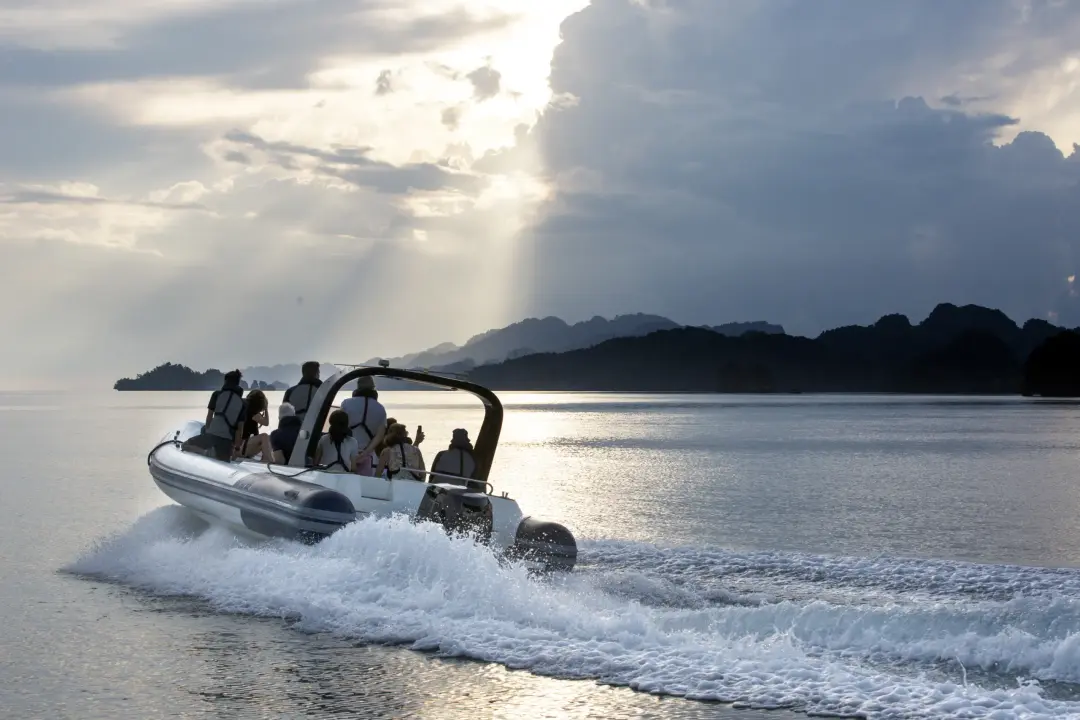
Baltra Island
Although it’s one of the smallest islands in the Galapagos archipelago, Baltra Island is one of the most frequently visited. After all, it houses one of only two airports in the region. Located near the center of the archipelago, this is a transit destination for all guests boarding the Aqua Mare to start their journey.
What is Baltra Island known for?
Created as a result of tectonic uplift, Baltra Island is characterized by its arid landscape and desert-like vegetation. The island has an abundance of salt bushes, Palo Santo trees, and prickly pear cactus.
If you spot cactus in the Galapagos Islands, chances are there’ll be land iguanas lurking nearby too. The dragon-like reptiles have a healthy population on Baltra today, despite a rough few decades of relocation.
In 1954, land iguanas were all but extinct on Baltra. Fortunately, twenty years prior, a subsection of their population had been moved to North Seymour by sea captain George Allan Hancock. These iguanas had managed to survive, and they eventually became a part of the Charles Darwin Research Station’s captive breeding program.
In the 1990s, land iguanas were reintroduced to Baltra Island. Since then, they’ve recorded a growth in their population and can now be commonly spotted by visitors. In fact, you might be greeted by land iguanas as soon as you land on Baltra. They’re known to roam on the runway and the island’s main roads.
Apart from land iguanas, Baltra Island is also home to a variety of endemic species such as lava gulls, boobies, and Galapagos sea lions.
When was Baltra Island discovered?
Along with the rest of the Galapagos archipelago, Baltra Island was discovered in 1535 by Spanish Bishop Tomás de Berlanga. It’s unclear how the island got its name – however, since Baltrais also a Spanish surname, the island is presumed to have been named after a person.
Fast forward to the 1930s, Baltra was visited by Franklin D. Roosevelt, who was the president of the United States at the time. The island was deemed to be an ideal location to establish an airbase by the US government. This was mostly due to its flat topography and central location.
Construction of the air base began midway through the Second World War, and in time, over a hundred buildings were built. These included barracks for soldiers, hangars, a beer garden, and even a bowling alley. The soldiers stationed at Baltra were considered to be some of the toughest members in the Air Force.
At the end of the war, the Ecuadorian government was given control of the base. They used it to establish their own airstrip in the Galapagos, which we know today as the Seymour Galapagos Ecological Airport. Today, Baltra Island serves as an official Ecuadorian military base. It is also the primary fueling station for boats out of Santa Cruz, which makes it an ideal location for the start of our expeditions through the Galapagos archipelago.
How to get to Baltra Island?
Baltra Island can only be reached from mainland Ecuador as there are no international flights which fly directly to the Galapagos Islands. There are daily flights which take visitors from Quito to Baltra Island, with a stopover at Guayaquil. The journey takes around two-and-a-half hours in total.
Our East Galapagos itinerary starts from Baltra Island itself, and guests are taken on a short cross island transfer to the jetty. On the other hand, our West Galapagos itinerary starts on the neighboring Santa Cruz island. This involves a cross island van and ferry transfer to Puerto Ayora.
Where do we go next?
Those traveling through East Galapagos will make their first stop at the beautiful white beach of Bahia Borrero, in the northern part of Santa Cruz. As one of the main tourism hubs in the Galapagos archipelago, Santa Cruz Island is a must-visit. It features attractions such as Dragon Hill, the Los Gemelos Twin Craters, and the Darwin Research Station.
Over on the West Galapagos itinerary, guests will depart from Santa Cruz Island after a day of excursions and arrive on Floreana Island the next morning. Floreana is an ideal place to observe wildlife, with sharks and stingrays swimming close to the shore, and greater flamingos feeding by the lagoon.
